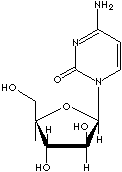PRODUCT IDENTIFICATION

H.S. CODE
TOXICITY
SMILES
CLASSIFICATION
Antiviral, Anti-Infective, Antimetabolite, Antineoplastic, Immunosuppressive
EXTRA NOTES
PHYSICAL AND CHEMICAL PROPERTIES
white to off-white crystalline powder
-2.48
REFRACTIVE INDEX
Stable under ordinary conditions.
EXTERNAL LINKS & GENERAL DESCRIPTION
Drug Information Portal (U.S. National Library of Medicine) - Cytarabine
PubChem Compound Summary - Cytarabine
Drug Bank - Cytarabine
KEGG (Kyoto Encyclopedia of Genes and Genomes) - Cytarabine
http://www.ebi.ac.uk/chebi/ - Cytarabine
http://www.ncbi.nlm.nih.gov/ - Cytarabine
http://www.medsafe.govt.nz/
Mechanism
of action: The exact mechanism(s) of action of cytarabine has not
been fully elucidated, however it appears to act through DNA synthesis
inhibition. Cytarabine is cytotoxic to a wide variety of proliferating
mammalian cells in culture. It exhibits cell phase specificity,
primarily killing cells undergoing DNA synthesis (S-phase) and under
certain conditions blocking the progression of cells from the G1
phase to the S-phase. A limited, but significant, incorporation
of cytarabine into both DNA and RNA has also been reported. Extensive
chromosomal damage, including chromatoid breaks, have been produced
by cytarabine and malignant transformation of rodent cells in culture
has been reported. Deoxycytidine prevents or delays (but does not
reverse) the cytotoxic activity.
http://www.bccancer.bc.ca/
MECHANISM
OF ACTION: Cytarabine, a synthetic pyrimidine nucleoside, is converted
intracellularly, primarily by deoxycytidine kinase, to active cytarabine
triphosphate. Activity occurs primarily as the result of inhibition
of DNA polymerase via competition with deoxycytidine triphosphate,
resulting in the inhibition of DNA synthesis. Incorporation of cytarabine
into DNA and RNA may contribute to cytotoxic effects. Cytarabine
also has antiviral and immunosuppressive properties. Cytarabine
is cell cycle phase-specific for the S-phase; cytarabine may also
block progression from the G1-phase to the S-phase. Both concentration
and duration of exposure are critical for cytotoxicity.
Local:
Cytarabine, cytosine arabinoside, is a synthetic nucleoside which differs from
cytidine and deoxycytidine in that the sugar moiety is arabinose rather than
ribose on deoxyribose. It is metabolically activated to the triphosphate
nucleotide (ara-CTP) which acts as an inhibitor of DNA polymerase and produces S
phase–specific cytotoxicity. It is used as an antineoplastic in the treatment of
acute lymphocytic, acute myelogenous leukemia, the blast phase of chronic
myelogenous leukemia, erythroleukemia, non-Hodgkin's lymphomais, prophylaxis,
and meningeal leukemia. Cyclocytidine is metabolized to cytarabine and thereby
maintains a more constant antineoplastic action. Cytarabine
(1-beta-D-Arabinofuranosylcytosine) is a white to off-white, crystalline powder;
freely soluble in water, slightly soluble in alcohol and in chloroform, insoluble in ether.
It also has antiviral and immunosuppressant properties.
APPEARANCE
fine off-white crystalline powder
IDENTIFICATION
Complies Test A,B
98.0 - 102.0 %
SPECIFIC ROTATION
+156° ~ +160° (C=1 in water)
HEAVY METALS
10ppm max
LOSS ON DRYING
1.0% max
RESIDUE ON IGNITION